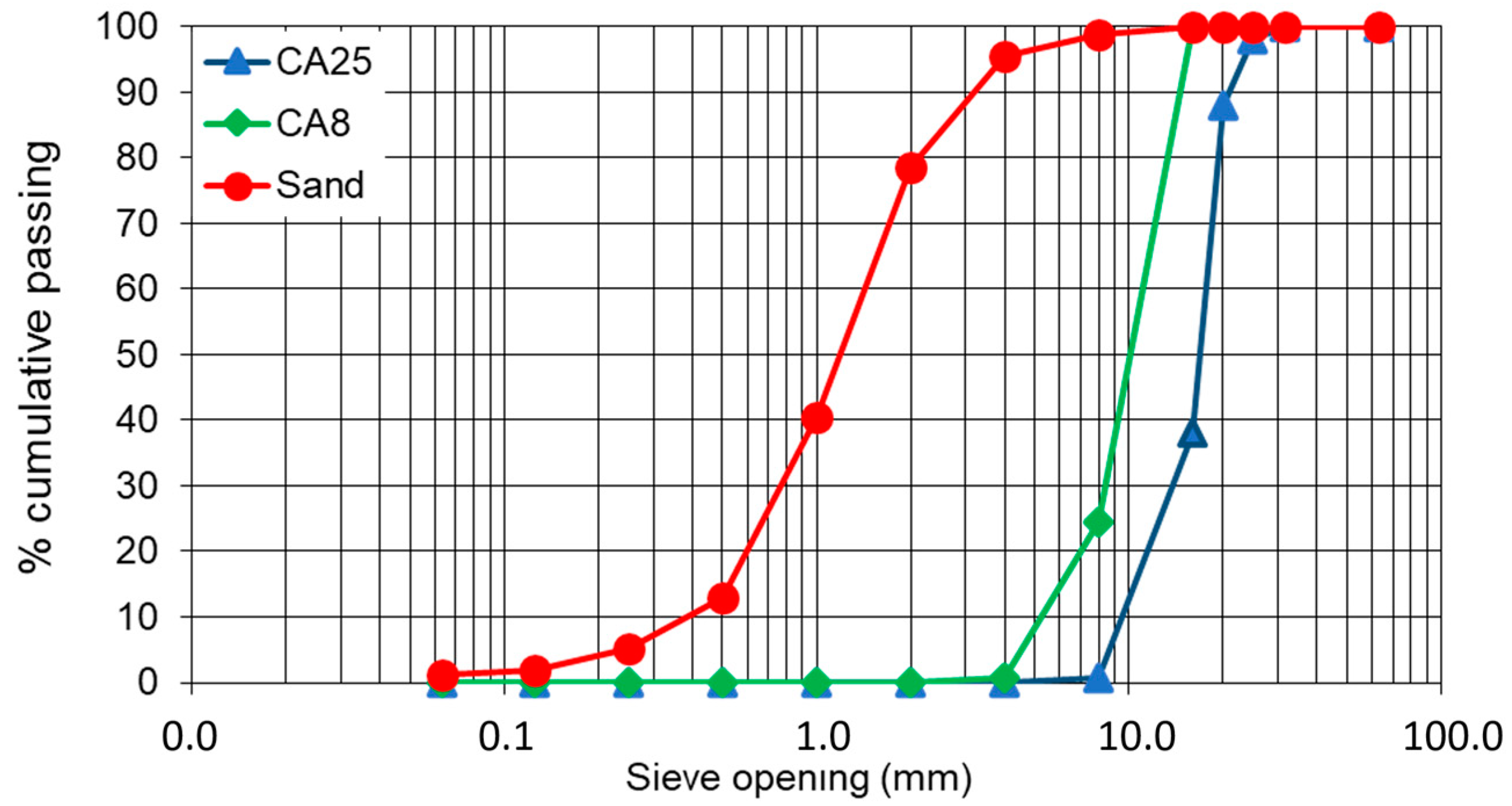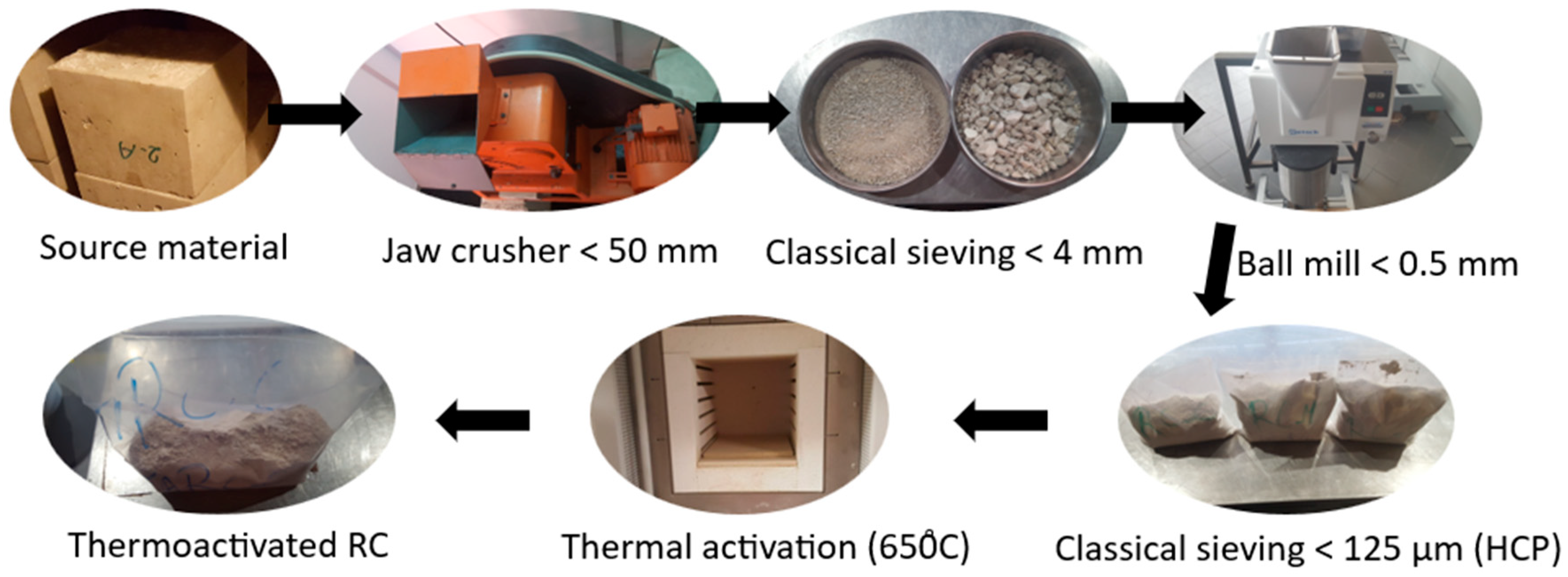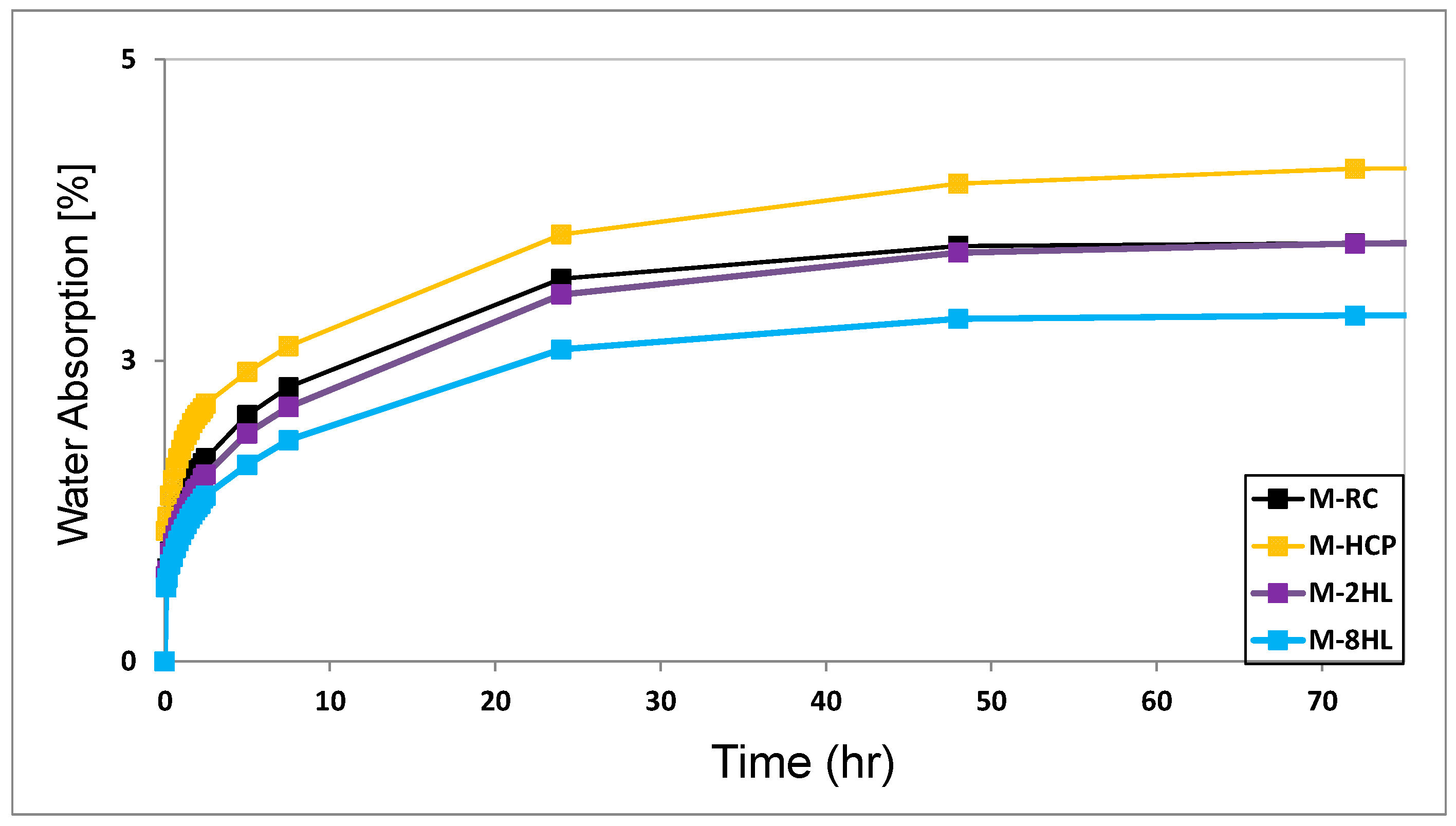Effect of Thermoactivated Recycled Cement, Hardened Cement Powder and Hydrated Lime on the Compressive Strength of Mortars
Abstract
1. Introduction
2. Experimental Procedure
2.1. Concrete as a Binder Source
2.2. Separation Process to Obtain HCP
2.3. Thermal Activation to Obtain Thermoactivated RC
2.4. Mix Design, Casting and Curing
2.5. Characterization Tests
- -
- Workability of mortars was evaluated through slump tests in accordance with EN1015-3 [31].
- -
- Mechanical characterization: compressive and flexural mechanical tests were carried out at the age of 7, 28 and 90 days on 4 × 4 × 4 cm3 cubes and 4 × 4 × 16 cm3 prisms, respectively, according to EN 1015-11 [32]. Three specimens were tested per mixture and curing age.
- -
- Thermogravimetric analysis was conducted as per [33], using a Labsys TG-DSC16 thermal analyser (Setaram, Carcavelos, Portugal).
- -
- X-ray diffraction (XRD) mineralogic composition analysis: an assessment of HCP was carried out using XRD. The data were collected using X’Pert-Pro MPD Philips/Panalytical diffractometer (Malvern Panalytical Ltd, Worcestershire, United Kingdom) equipped with K Cu radiation (λ = 1.5405 Å) operating at 40 mA and 45 KV. The scanning was conducted (2θ, Cu-kα) between 5° and 60° at a scan speed of 0.02°/s [34].
3. Results and Discussion
3.1. Workability
3.2. Compressive and Flexural Strength Strength
3.3. Mineralogic Characterization by XRD
3.4. Capillary Water Absorption
4. Conclusions
- The replacement of OPC by 25% of RC reported a 31.1%, 18.8% and 20.2% loss in compressive strength at 7, 28 and 90 days, respectively.
- The thermal activation at 650 ° C of HCP reported an increase in compressive strength by 11.5%.
- Though XRD carried on at HCP from concrete source did not show the presence of SiO2, M-HCP8HL reported 12.18% increase in compressive strength and 21.62% in flexural strength from 28 to 90 days more than any other mixture. Further experimental investigations are required to examine HCP from cement paste as the XRD conducted on the latter demonstrated the presence of SiO2.
Author Contributions
Funding
Institutional Review Board Statement
Informed Consent Statement
Data Availability Statement
Conflicts of Interest
References
- Fardoun, H.; Saliba, J.; Coureau, J.-L.; Cointe, A.; Saiyouri, N. Long-Term Deformations and Mechanical Properties of Fine Recycled Aggregate Earth Concrete. Appl. Sci. 2022, 12, 11489. [Google Scholar] [CrossRef]
- Fardoun, H.; Saliba, J.; Saiyouri, N. Earth concrete under cyclic loadings: Stress-strain curves and damage assessment by means of acoustic emission and digital image correlation techniques. Mech. Res. Commun. 2023, 131, 104158. [Google Scholar] [CrossRef]
- Tam, V.W.; Soomro, M.; Evangelista, A.C.J. Quality improvement of recycled concrete aggregate by removal of residual mortar: A comprehensive review of approaches adopted. Constr. Build. Mater. 2021, 288, 123066. [Google Scholar] [CrossRef]
- Wang, R.; Yu, N.; Li, Y. Methods for improving the microstructure of recycled concrete aggregate: A review. Constr. Build. Mater. 2020, 242, 118164. [Google Scholar] [CrossRef]
- Fardoun, H.; Saliba, J.; Saiyouri, N. Evolution of acoustic emission activity throughout fine recycled aggregate earth concrete under compressive tests. Theor. Appl. Fract. Mech. 2022, 119, 103365. [Google Scholar] [CrossRef]
- He, Z.; Shen, A.; Lyu, Z.; Li, Y.; Wu, H.; Wang, W. Effect of wollastonite microfibers as cement replacement on the properties of cementitious composites: A review. Constr. Build. Mater. 2020, 261, 119920. [Google Scholar] [CrossRef]
- Letelier, V.; Tarela, E.; Muñoz, P.; Moriconi, G. Combined effects of recycled hydrated cement and recycled aggregates on the mechanical properties of concrete. Constr. Build. Mater. 2017, 132, 365–375. [Google Scholar] [CrossRef]
- Fennell, P.; Driver, J.; Bataille, C.; Davis, S.J. Cement and steel—Nine steps to net zero. Nature 2022, 603, 574–577. [Google Scholar] [CrossRef] [PubMed]
- Monteiro, P.J.M.; Miller, S.A.; Horvath, A. Towards sustainable concrete. Nat. Mater. 2017, 16, 698–699. [Google Scholar] [CrossRef]
- Bogas, J.A.; Carriço, A.; Tenza-Abril, A.J. Microstructure of thermoactivated recycled cement pastes. Cem. Concr. Res. 2020, 138, 106226. [Google Scholar] [CrossRef]
- Bogas, J.; Carriço, A.; Pereira, M. Mechanical characterization of thermal activated low-carbon recycled cement mortars. J. Clean. Prod. 2019, 218, 377–389. [Google Scholar] [CrossRef]
- Carriço, A.; Real, S.; Bogas, J.A. Durability performance of thermoactivated recycled cement concrete. Cem. Concr. Compos. 2021, 124, 104270. [Google Scholar] [CrossRef]
- Carriço, A.; Real, S.; Bogas, J.A.; Pereira, M.F.C. Mortars with thermo activated recycled cement: Fresh and mechanical characterisation. Constr. Build. Mater. 2020, 256, 119502. [Google Scholar] [CrossRef]
- Carriço, A.; Bogas, J.A.; Guedes, M. Thermoactivated cementitious materials—A review. Constr. Build. Mater. 2020, 250, 118873. [Google Scholar] [CrossRef]
- Real, S.; Bogas, J.A.; Carriço, A.; Hu, S. Mechanical Characterisation and Shrinkage of Thermoactivated Recycled Cement Concrete. Appl. Sci. 2021, 11, 2454. [Google Scholar] [CrossRef]
- Semugaza, G.; Mielke, T.; Castillo, M.E.; Gierth, A.Z.; Tam, J.X.; Nawrath, S.; Lupascu, D.C. Reactivation of hydrated cement powder by thermal treatment for partial replacement of ordinary portland cement. Mater. Struct. 2023, 56, 48. [Google Scholar] [CrossRef]
- Wang, J.; Xu, L.; Li, M.; Wang, Y.; He, H.; Xiang, D.; Li, K.; Hao, T. Investigations on factors influencing physical properties of recycled cement and the related carbon emissions and energy consumptions. J. Clean. Prod. 2023, 414, 137715. [Google Scholar] [CrossRef]
- Xu, L.; Wang, J.; Li, K.; Lin, S.; Li, M.; Hao, T.; Ling, Z.; Xiang, D.; Wang, T. A systematic review of factors affecting properties of thermal-activated recycled cement. Resour. Conserv. Recycl. 2022, 185, 106432. [Google Scholar] [CrossRef]
- Wang, J.; Mu, M.; Liu, Y. Recycled cement. Constr. Build. Mater. 2018, 190, 1124–1132. [Google Scholar] [CrossRef]
- Serpell, R.; Zunino, F. Recycling of hydrated cement pastes by synthesis of α′H-C2S. Cem. Concr. Res. 2017, 100, 398–412. [Google Scholar] [CrossRef]
- Valcuende, M.; Calabuig, R.; Martínez-Ibernón, A.; Soto, J. Influence of Hydrated Lime on the Chloride-Induced Reinforcement Corrosion in Eco-Efficient Concretes Made with High-Volume Fly Ash. Materials 2020, 13, 5135. [Google Scholar] [CrossRef] [PubMed]
- Zhang, G.; Peng, G.F.; Zuo, X.Y.; Niu, X.J.; Ding, H. Adding hydrated lime for improving microstructure and mechanical properties of mortar for ultra-high performance concrete. Cem. Concr. Res. 2023, 167, 107130. [Google Scholar] [CrossRef]
- Yang, Y.; Xu, J.; Zhan, B.; Gao, P.; Yu, Q.; Li, R.; Wang, J.; Wang, A.; Liu, G.; Zhang, Y. Study on hydration characteristics and mechanism of recycled powder-cement binary and multivariate systems. Constr. Build. Mater. 2024, 420, 135646. [Google Scholar] [CrossRef]
- Maljaee, H.; Paiva, H.; Madadi, R.; Tarelho, L.A.; Morais, M.; Ferreira, V.M. Effect of cement partial substitution by waste-based biochar in mortars properties. Constr. Build. Mater. 2021, 301, 124074. [Google Scholar] [CrossRef]
- Rostami, V.; Shao, Y.; Boyd, A.J.; He, Z. Microstructure of cement paste subject to early carbonation curing. Cem. Concr. Res. 2012, 42, 186–193. [Google Scholar] [CrossRef]
- Sharma, R.; Pandey, S. Influence of mineral additives on the hydration characteristics of ordinary Portland cement. Cem. Concr. Res. 1999, 29, 1525–1529. [Google Scholar] [CrossRef]
- Gupta, S.; Kua, H.W.; Low, C.Y. Use of biochar as carbon sequestering additive in cement mortar. Cem. Concr. Compos. 2018, 87, 110–129. [Google Scholar] [CrossRef]
- Short, N.R.; Purnell, P.; Page, C.L. Preliminary investigations into the supercritical carbonation of cement pastes. J. Mater. Sci. 2001, 36, 35–41. [Google Scholar] [CrossRef]
- Alonso, C.; Fernandez, L. Dehydration and rehydration processes of cement paste exposed to high temperature environments. J. Mater. Sci. 2004, 39, 3015–3024. [Google Scholar] [CrossRef]
- Tajuelo Rodriguez, E.; Garbev, K.; Merz, D.; Black, L.; Richardson, I.G. Thermal stability of C-S-H phases and applicability of Richardson and Groves’ and Richardson C-(A)-S-H(I) models to synthetic C-S-H. Cem. Concr. Res. 2017, 93, 45–56. [Google Scholar] [CrossRef]
- NF EN 1015-3; Methods of Test for Mortar for Masonry, Part 3: Determination of Consistence of Fresh Mortar (by Flow Table). Association Française de Normalisation: The Saint-Denis Plain, France, 1999.
- NF EN 1015-11; Methods of Test for Mortar for Masonry—Part 11: Determination of Flexural and Compressive Strength of Hardened Mortar. Association Française de Normalisation: The Saint-Denis Plain, France, 2019.
- ASTM C1872-18; Standard Test Method for Thermogravimetric Analysis of Hydraulic Cement. ASTM International: West Conshohocken, PA, USA, 2018. [CrossRef]
- EN 13925-1; Non-Destructive Testing-X-ray Diffraction from Polycrystalline and Amorphous Material-Part 1: General Principles. European Standards: Brussels, Belgium, 2008.
- NF EN 1015-18; Methods of Test for Mortar for Masonary, Part 18: Determination of Water Absorption Coefficient Due to Capillary Action of Hardened Mortar. Association Française de Normalisation: The Saint-Denis Plain, France, 2003.
- Shui, Z.; Xuan, D.; Chen, W.; Yu, R.; Zhang, R. Cementitious characteristics of hydrated cement paste subjected to various dehydration temperatures. Constr. Build. Mater. 2009, 23, 531–537. [Google Scholar] [CrossRef]
- Yu, R.; Shui, Z. Influence of agglomeration of a recycled cement additive on the hydration and microstructure development of cement-based materials. Constr. Build. Mater. 2013, 49, 841–851. [Google Scholar] [CrossRef]
- Shafiei, A.; Namin, M.L. Experimental investigation on the effect of hydrated lime on mechanical properties of SMA. Constr. Build. Mater. 2014, 70, 379–387. [Google Scholar] [CrossRef]
- Thomas, B.S.; Gupta, R.C. Long term behaviour of cement concrete containing discarded tire rubber. J. Clean. Prod. 2015, 102, 78–87. [Google Scholar] [CrossRef]
- Brostow, W.; Chetuya, N.; Hnatchuk, N.; Uygunoglu, T. Reinforcing concrete: Comparison of filler effects. J. Clean. Prod. 2016, 112, 2243–2248. [Google Scholar] [CrossRef]








| Cement (g) | RC (g) | HCP (g) | HL (g) | w/c | Sand (g) | SP (%) | Slump (mm) | |
|---|---|---|---|---|---|---|---|---|
| REF | 500 | - | - | - | 0.5 | 1500 | 0.2 | 230 |
| M-RC | 375 | 125 | - | - | 0.5 | 1500 | 0.3 | 225 |
| M-HCP | 375 | - | 125 | - | 0.5 | 1500 | 0.2 | 220 |
| M-HCP2HL | 375 | - | 125 | 10 | 0.5 | 1500 | 0.2 | 240 |
| M-HCP5HL | 375 | - | 125 | 25 | 0.5 | 1500 | 0.25 | 235 |
| M-HCP8HL | 375 | - | 125 | 41 | 0.5 | 1500 | 0.27 | 225 |
Disclaimer/Publisher’s Note: The statements, opinions and data contained in all publications are solely those of the individual author(s) and contributor(s) and not of MDPI and/or the editor(s). MDPI and/or the editor(s) disclaim responsibility for any injury to people or property resulting from any ideas, methods, instructions or products referred to in the content. |
© 2024 by the authors. Licensee MDPI, Basel, Switzerland. This article is an open access article distributed under the terms and conditions of the Creative Commons Attribution (CC BY) license (https://creativecommons.org/licenses/by/4.0/).
Share and Cite
Fardoun, H.; Ascensão, G.; Mantas, P.; Ferreira, V. Effect of Thermoactivated Recycled Cement, Hardened Cement Powder and Hydrated Lime on the Compressive Strength of Mortars. Materials 2024, 17, 4002. https://doi.org/10.3390/ma17164002
Fardoun H, Ascensão G, Mantas P, Ferreira V. Effect of Thermoactivated Recycled Cement, Hardened Cement Powder and Hydrated Lime on the Compressive Strength of Mortars. Materials. 2024; 17(16):4002. https://doi.org/10.3390/ma17164002
Chicago/Turabian StyleFardoun, Hassan, Guilherme Ascensão, Pedro Mantas, and Victor Ferreira. 2024. "Effect of Thermoactivated Recycled Cement, Hardened Cement Powder and Hydrated Lime on the Compressive Strength of Mortars" Materials 17, no. 16: 4002. https://doi.org/10.3390/ma17164002
APA StyleFardoun, H., Ascensão, G., Mantas, P., & Ferreira, V. (2024). Effect of Thermoactivated Recycled Cement, Hardened Cement Powder and Hydrated Lime on the Compressive Strength of Mortars. Materials, 17(16), 4002. https://doi.org/10.3390/ma17164002








